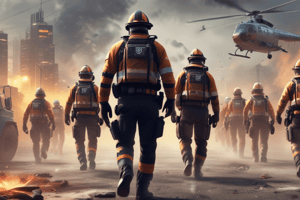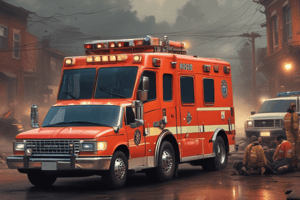Podcast
Questions and Answers
What is the primary focus of the sequence represented in the content?
What is the primary focus of the sequence represented in the content?
- Static states
- Random occurrences
- Cyclic patterns
- Linear progression of events (correct)
Which of the following best describes the relationships shown in the content?
Which of the following best describes the relationships shown in the content?
- Independent actions with no consequences
- Contradictory pathways
- Collaboration towards a unified goal (correct)
- Interconnected but separate processes
What type of movement does the content suggest?
What type of movement does the content suggest?
- Slow and restrained
- Erratic and unpredictable
- Chaotic and random
- Fluid and adaptive (correct)
What can be inferred about the overall direction presented in the content?
What can be inferred about the overall direction presented in the content?
How does the content portray the significance of transitions between stages?
How does the content portray the significance of transitions between stages?
Welches der folgenden Elemente stellt eine eindeutige Veränderung im Prozess dar?
Welches der folgenden Elemente stellt eine eindeutige Veränderung im Prozess dar?
Welche der folgenden Aussagen beschreibt am besten eine vermutete Richtung im dargestellten Inhalt?
Welche der folgenden Aussagen beschreibt am besten eine vermutete Richtung im dargestellten Inhalt?
Was könnte als Hindernis im dargestellten Prozess interpretiert werden?
Was könnte als Hindernis im dargestellten Prozess interpretiert werden?
Welche der folgenden Optionen repräsentiert am wenigsten die Idee von fortschreitenden Veränderungen?
Welche der folgenden Optionen repräsentiert am wenigsten die Idee von fortschreitenden Veränderungen?
Welcher Aspekt des dargestellten Inhalts könnte als essentiell für das Verständnis der Bewegung betrachtet werden?
Welcher Aspekt des dargestellten Inhalts könnte als essentiell für das Verständnis der Bewegung betrachtet werden?
Flashcards
Arrows
Arrows
Visual representations of relationships or directions.
Directions
Directions
Indicating movement or progression from one point to another.
Relationships
Relationships
Connections between different things.
Visual representations
Visual representations
Signup and view all the flashcards
Complex Systems
Complex Systems
Signup and view all the flashcards
Visual Representation
Visual Representation
Signup and view all the flashcards
Directional Flow
Directional Flow
Signup and view all the flashcards
Complex Network
Complex Network
Signup and view all the flashcards
System Relationships
System Relationships
Signup and view all the flashcards
Interconnected Parts
Interconnected Parts
Signup and view all the flashcards
Study Notes
General Accident
- First Phase Challenges: First responders face unique challenges in large-scale incidents, contrasting with individual emergencies. Initial circumstances include inexperienced personnel, chaotic scenes, and overwhelming situations, needing a shift from routine responses. This involves understanding site context with casualties, uninjured, eyewitnesses, and first responders; stress is a significant concern.
Force Discrepancy
- Imbalance of Resources: Initial large-scale deployments often exhibit a dramatic imbalance between the few responders and a large number of victims. An immediate and directed course of action is critical. This highlights the need to prioritize the most seriously injured.
Prioritization of Care
- Balancing Patient Care: Maintaining the highest attainable care levels is essential but must also address the largest possible number of patients simultaneously. Switching from individual treatment of patients to focused group care is required to care for the majority of patients. It is difficult because normal practices are challenged by stress and emotion in such a chaotic environment.
Understanding SanHiSt
- Systemic Approach: Large-scale incidents require a systematic approach to patient management. The SanHiSt system represents a well-organized structure for handling large-scale scenarios. The organization and treatment phases must work together.
Leadership in Large-Scale Events
- Differences in Leadership: Individual and mass-casualty incidents differ significantly in leadership requirements. Routine response and significant emergency responses have different needs and responsibilities. Larger deployments demand structured, established processes, whereas individual emergencies may employ adaptable and flexible approaches.
Emergency Response Structure and Processes
- Operational Processes and Procedures: The text highlights the roles, responsibilities, and operational procedures in emergency response situations. This includes the use of established channels, protocols and decision-making parameters. In routine operations, communication and established structures are crucial.
Expert Opinions (or Professionals)
- Expert Responsibility: The text describes experts’ liability for their professional guidance and decisions. It outlines the duties of professionals, specifically focusing on the responsibilities of emergency responders to ensure proper treatment and procedures are followed.
Defining Emergencies
- Defining Emergencies: The text outlines the distinctions between major emergencies and disasters. It focuses on the criteria used to make this determination.
Personnel Responsibilities
- Specific roles: The text elucidates the roles and responsibilities of various personnel during emergency incidents. It specifies responsibilities for first responders, leaders, and support staff.
Studying That Suits You
Use AI to generate personalized quizzes and flashcards to suit your learning preferences.




